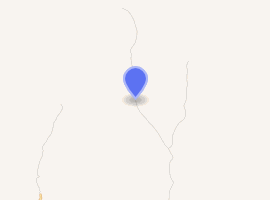Oregon Vortex
The Oregon Vortex is a roadside attraction that opened to tourists in 1930,[1] located on Sardine Creek[2] in Gold Hill, Oregon, in the United States. It consists of a number of interesting effects, which are gravity hill optical illusions, but which the attraction's proprietors propose are the result of paranormal properties of the area.[3] It is located at 42.49313°N 123.085113°W.
| The Oregon Vortex | |
|---|---|
.jpg) | |

| |
| Nearest city | Gold Hill, Oregon U.S. |
| Coordinates | 42.49313°N 123.085113°W |
Background
Prior to any construction of the area, local legend had it that Native Americans in the area referred to the site as a "forbidden" land, and travelers passing through would often find their horses refusing to go through the area.[4]
A gold assay office was built in the area in 1904 by the Old Grey Eagle Mining Company, which slid from its foundation in the early tens, coming to rest at an odd angle. In 1914 the outpost and assay house were rediscovered by a prospector named William McCollugh. McCollugh convinced his friend, geologist and engineer John Litster to come to the US from his birth place in Alva, Scotland. Litster says he researched the paranormal phenomena of the so-called 165-foot magnet radius.[1]
When Litster died in 1959, his wife sold the Oregon Vortex to Ernie and Irene Cooper. The Coopers' daughter Maria and grandson Mark kept the attraction open since then, making it one of Oregon's oldest examples of Roadside Americana.[1]
Odd angles create an illusion of objects seemingly rolling uphill. The same effect can be seen in The Montana Vortex and house of mystery, Pennsylvania's Laurel Caverns, and at Santa Cruz, California's Mystery Spot. Two UC Berkeley researchers studied the Santa Cruz Mystery Spot and published their conclusions in Psychological Science in 1999. They proposed that a framework called orientation framing which describes how the brain's visual processing uses spatial frames of reference. They noted similar illusions including the Ponzo illusion, the Zöllner illusion, the Poggendorf and Wündt-Hering illusions.[5] James Randi, magician and illusionist, also described the Oregon Vortex (House of Mystery) as an optical illusion in 1998 using photography and mathematics to describe the illusion.[6] Russ Donnelly, professor emeritus of physics at the University of Oregon visited the Oregon Vortex in 1966 and was convinced it was some sort of optical illusion. Owner Maria Cooper agreed with Donnelly that what people are seeing inside the House of Mystery is an optical illusion but insisted something else was happening outside the house that make people height appearing to grow and shrink depending on their location. [7]
Oregon Vortex is also famous for "height change" as the apparent relative height of two people varies, depending on where each stands.[8] The explanation of the strange phenomena is that they are caused by optical illusions.[9] Distorted backgrounds that induce a forced perspective, as with an Ames room. [10] The Oregon site also exhibits phenomena similar to those perceived by visitors at the mystery spot located outside St. Ignace in the upper peninsula of Michigan.[11]
In popular culture
- The site was investigated on a second season episode of the SyFy reality show Fact or Faked: Paranormal Files, and although there seemed to be a small debate between the show's investigators over the "height change" phenomenon, they ultimately concluded that overall, all of the effects demonstrated were optical illusions.[12]
- It was also mentioned on season 3, episode 11 ("Mystery Spot"), of The CW's Supernatural by Jared Padalecki's character, Sam Winchester.[13]
- The Oregon Vortex was featured in a 1999 episode of X-Files.[14]
- The attraction is the inspiration for the Mystery Shack, a tourist trap and the main setting for the Disney Channel (later Disney XD) original series Gravity Falls.[15]
- The Oregon Vortex continues to attract visitors from around the world whether it is an optical illusion or some phenomena that bend light, defy gravity and/or alter mass is not understood.[16]
See also
- Mystery Spot, a similar attraction in Santa Cruz, California
References
- "Oregon Vortex (House of Mystery)". oregonencyclopedia.org. Retrieved 2020-03-29.
- "Oregon Vortex". Oregon Vortex. Retrieved 2020-07-02.
- Hauck, Dennis (1996). Haunted Places: The National Directory : A Guidebook to Ghostly Abodes, Sacred Sites, UFO Landings, and Other Supernatural Locations. Penguin. p. 344. ISBN 978-0-14200-234-6.
- Weeks, Andy. Haunted Oregon: Ghosts and Strange Phenomena of the Beaver State. Stackpole Books. pp. 59–61.
- Shimamura, Arthur P.; Prinzmetal, William (1 November 1999). "The Mystery spot Illusion and Its Relation to Other Visual Illusions". Psychological Science. 10 (6): 501–507. doi:10.1111/1467-9280.00196.
- "Oregon Vortex (House of Mystery)". oregonencyclopedia.org. Retrieved 2020-07-02.
- "Penn State WebAccess Secure Login". webaccess.psu.edu. Retrieved 2020-07-03.
- Oregon Vortex official website. Retrieved December 2008.
- Baskas, Harriet Baskas By Harriet. "Oregon Vortex Offers A Spooky Mystery For All". www.opb.org. Retrieved 2020-03-29.
- Oregon No-Vortex Retrieved December 2008.
- "Mystery Spots". Skeptoid. Retrieved 2020-03-29.
- Butler, Grant (June 20, 2012). "'Fact or Faked: Paranormal Files' investigates Oregon Vortex: Optical illusions or unexplained mysteries?". Oregon Live. Retrieved January 22, 2016.
- Supernatural. Season 3. Episode 11. The CW.
- Willford, Tyler (2016-06-22). "The Oregon Vortex is One of the Strangest Places On Earth". That Oregon Life. Retrieved 2020-03-29.
- Owen, Rob (2012-06-14). "'Gravity Falls': Inspired by Boring, Ore.? It's true". Retrieved 2020-06-16.
- "Oregon Vortex (House of Mystery)". oregonencyclopedia.org. Retrieved 2020-07-02.